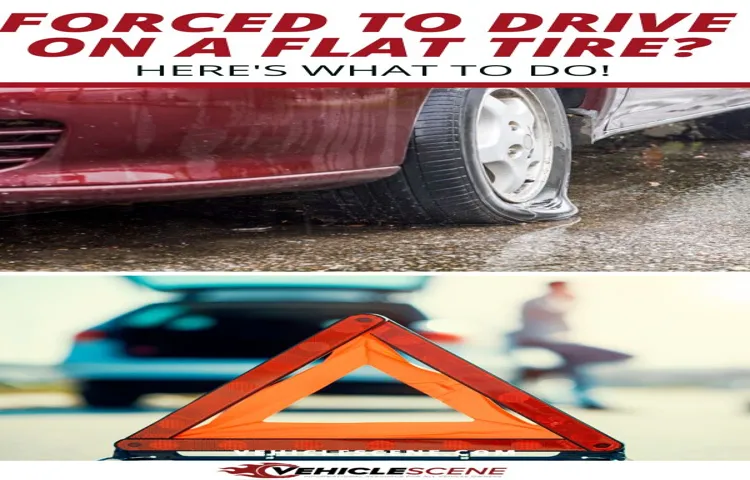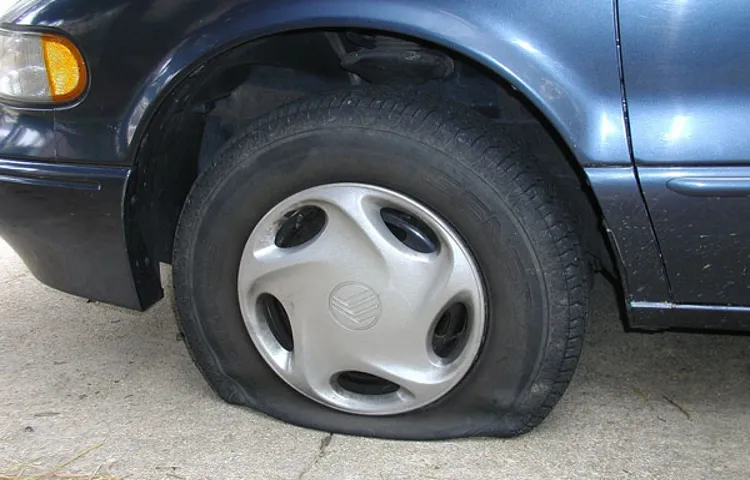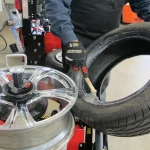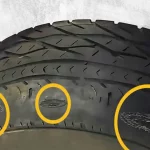Flat tires can happen to anyone, anywhere, at any time. But when you get a flat tire on the highway, it can be particularly stressful and dangerous. You may be wondering what to do next, how to stay safe, and how to get back on the road as quickly as possible.
But fear not – we’ve put together a guide to help you navigate this potentially tricky situation. Whether you’re a new driver or a seasoned pro, these tips will come in handy the next time you find yourself with a flat tire on the highway. So sit back, buckle up, and let’s dive in.
Table of Contents
Stay Calm and Focus on Safety
Getting a flat tire on the highway can be stressful, but it’s important to stay calm and focus on safety. The first thing you should do is find a safe place to pull over, such as a shoulder or rest area. Turn on your hazard lights to alert other drivers and exit the vehicle on the side away from traffic.
Before changing the tire, make sure to check your owner’s manual for specific instructions. If you don’t feel comfortable changing the tire, call for roadside assistance or a tow truck. Remember that safety should always come first, so never attempt to change a tire in an unsafe or busy area.
With a little patience and preparation, you can handle a flat tire with ease.
Find a Safe Place to Stop
When your car starts to malfunction or you notice a strange noise coming from the engine, it’s important to find a safe place to stop. Stay calm and focus on getting to a spot where you can safely pull over and assess the situation. This could be a shoulder on the side of the road or a nearby parking lot.
Remember to use your turn signal and check for traffic before changing lanes or turning. It’s important to keep your safety and the safety of others in mind, even when you are feeling stressed or anxious. Once you have found a safe place to pull over, take a deep breath and assess the situation.
Are you able to fix the issue yourself, or do you need to call for assistance? By keeping a clear head and staying focused on safety, you can navigate any situation that arises on the road.

Turn on Hazard Lights and Apply the Parking Brake
When a hazardous situation arises on the road, the first thing you should do is turn on your hazard lights and apply the parking brake. It’s important to stay calm and focus on safety despite the urgency of the moment. Turning on your hazard lights alerts other drivers that there’s a problem and to approach with caution.
The parking brake keeps your vehicle stationary and prevents any additional accidents from occurring. Additionally, remaining calm allows you to think clearly and make rational decisions about how to proceed. Remember to always prioritize safety above everything else and take the necessary precautions to prevent any further harm.
By taking these steps, you can keep yourself and other drivers safe on the road.
Stay in Your Vehicle If Possible
When it comes to driving, unexpected situations can arise at a moment’s notice, making it important to stay calm and focused. One such scenario is finding yourself stranded on the side of the road due to car trouble. If this happens, the best advice is to stay in your vehicle if possible.
This is especially important if you’re in an area with heavy traffic or adverse weather conditions. When you remain in your vehicle, you are protected from other drivers on the road and can avoid further accidents. If you must exit the vehicle, be sure to do so safely and stay as far away from traffic as possible.
In the event that you need to wait for help, make sure your hazard lights are on and have bottled water and snacks on hand. Remember, staying in your vehicle is always the safest option when you’re stranded on the side of the road.
Assess the Damage and Gather Tools
Getting a flat tire on the highway can be a stressful situation, but it’s important to remain calm and assess the damage. Pull over to a safe location as quickly as possible and turn on your hazard lights. Once you’ve come to a stop, get your tire changing tools out and ready.
These typically include a jack, lug wrench, and spare tire. Inspect the tire to assess the extent of the damage and determine if it’s safe to attempt changing the tire yourself. If the damage is too severe or you don’t feel comfortable, it’s best to call for roadside assistance.
Remember, safety should always be your top priority in this situation.
Check the Tire’s Condition and Location of the Flat
When faced with a flat tire, taking the time to assess the damage and gather tools can go a long way in making the process go smoothly. Start by examining the tire’s condition – is the puncture repairable or does the tire need to be replaced? Once you’ve determined the severity of the damage, gather the necessary tools. A spare tire, jack, lug wrench, and tire iron are essential when changing a tire.
Don’t forget to check the location of the flat as well – if it’s on a busy road or uneven terrain, consider safety precautions to prevent injury or damage to your vehicle. By taking the time to properly assess the situation and gather the right tools, changing a flat tire can be a manageable task. So, take a deep breath, roll up your sleeves, and let’s get this tire changed!
Gather Necessary Tools, Including a Spare Tire and Jack
When assessing damage to your vehicle, it’s important to gather all the necessary tools before you begin any DIY repairs. This includes a spare tire and a jack to lift the vehicle from the ground. Assessing the damage may seem daunting, but by taking a systematic approach, you can determine the extent of the problem and the tools you’ll need to fix it.
Start by checking the exterior of the vehicle for any visible damage, such as dents or scratches. Then move on to the wheels and tires, looking for any signs of wear or damage. Once you’ve identified the problem areas, gather the necessary tools to fix the damage.
Work carefully and methodically, referring to your vehicle’s user manual if necessary. Remember, safety should always be your top priority when working on your vehicle, so take precautions to protect yourself and those around you. With the right approach and the right tools, you can tackle almost any vehicle repair task with confidence.
Replace the Flat Tire
Having a flat tire on the highway can be a nerve-wracking experience, but it’s important to stay calm and handle the situation properly. The first step is to safely move your vehicle to the side of the road, as far away from traffic as possible. Turn on your hazard lights and park on flat ground, away from any curves or hills.
Once you’re safely parked, get your spare tire, jack, and lug wrench from your trunk, and swap out the flat tire with the spare. Remember to tighten the lug nuts in a star pattern and lower the jack before driving. If you’re not comfortable changing the tire yourself, call for roadside assistance or wait for help from a passerby.
Whatever you do, never attempt to drive on a flat tire as this can cause serious damage to your car and put you and others in danger on the road.
Loosen Lug Nuts Before Lifting the Vehicle
When you’re on the road and suddenly find yourself with a flat tire, it’s important to know how to replace it safely and effectively. One crucial step to keep in mind is to loosen the lug nuts before lifting the vehicle. Why is this important? When you try to loosen the lug nuts after lifting the car, the wheel will just spin with the lug nut instead of coming off.
This is because the tire is off the ground and there’s no resistance. To avoid this, you should use a lug wrench to loosen the lug nuts while the car is still on the ground. Once you’ve done that, you can safely jack up the car, remove the lug nuts completely, and replace the flat tire with the spare.
Remember to tighten the lug nuts in a star pattern to ensure they are evenly distributed and secure. By following these steps, you’ll be back on the road in no time.
Use Jack to Lift the Vehicle
One of the most essential steps in replacing a flat tire is using a jack to lift the vehicle. A jack is a crucial tool that enables you to raise the car off the ground, creating enough space to remove the flat tire and replace it with a spare one. It is crucial to position the jack in the right spot, which varies depending on the make and model of the vehicle.
You can check the owner’s manual for specifics on where to place the jack, usually under the designated lift points. Once the jack is in position, rotate the handle or pump the lever to lift the vehicle slowly. Always follow safety precautions when lifting the car, such as engaging the parking brake and using safety stands for added stability.
With the car raised, removing the flat tire is the next logical step, but be careful to avoid accidents when working around the car on jacks. Proper use of a jack is essential for replacing a flat tire safely and efficiently.
Remove Flat Tire and Replace with Spare Tire
Replacing a flat tire with a spare tire can be a tricky and daunting task for many drivers, especially if they’ve never done it before. But don’t worry, it’s easier than it sounds! The first step is to park on a flat surface and turn on your hazard lights. Then, use a lug wrench to remove the lug nuts on the flat tire.
Once all of the nuts are removed, carefully lift the flat tire off of the car and set it aside. Take the spare tire out of the trunk and place it onto the wheel studs, making sure the holes align. Then, tighten the lug nuts by hand as much as possible before using the lug wrench to fully secure them.
Be sure to lower the car jack and remove it from underneath the car before driving on the spare tire. Remember to get the flat tire repaired as soon as possible and always drive with caution when using a spare tire. With a little practice, you’ll be a pro at changing a flat tire in no time!
Lower the Vehicle and Tighten Lug Nuts
When you find yourself with a flat tire, your priority is to safely replace it. Begin by pulling over to a level surface and engaging your car’s emergency brake to prevent any sudden movement. Next, lower the vehicle using a jack so that the flat tire is hovering slightly above the ground.
It’s important to make sure that the jack holds the vehicle steady to avoid any accidents. Once the vehicle is lowered, use a wrench to tighten the lug nuts on the flat tire. Take care not to over-tighten them, as this will make it difficult to remove them later.
Now that the tire is secure, you can remove it and replace it with the spare. Make sure the new tire is properly aligned before securing it with the lug nuts. The process may seem daunting, but with a little patience and care, you can replace the flat tire safely and efficiently.
Get to a Professional as Soon as Possible
Getting a flat tire on the highway can be a nerve-wracking experience that can potentially lead to serious consequences. The first thing to do when this happens is to calmly and carefully move your vehicle to a safe area away from other vehicles, preferably to the shoulder of the road. Once you have achieved a safe spot, assess the damage and determine whether it’s safe to replace the tire yourself or seek professional assistance.
If you are not comfortable or confident in changing a tire, don’t take any risks. Instead, call a roadside assistance service or a professional mechanic to come and replace the tire for you. Remember that your safety should always come first.
Driving on a flat tire can lead to further damage and potentially cause an accident. So, get to a professional as soon as possible.
Drive Slowly to a Safe Location or Auto Shop
When driving, it’s important to always prioritize your safety. If you notice something off with your car, don’t ignore it and hope the problem will go away on its own. Instead, drive slowly to a safe location or an auto shop to ensure that you and your vehicle are taken care of.
Sometimes, minor issues like a warning light or strange noises can indicate a larger problem that requires immediate attention. By getting your car to a professional as soon as possible, you can prevent further damage and ensure that your vehicle is running in top shape. Remember, your car is an important investment, so take care of it and don’t hesitate to seek help when needed.
Get a Professional Inspection and Repair
When it comes to your home’s safety, getting a professional inspection and repair as soon as possible is crucial. You never know when a small issue could become a major problem, risking the integrity of your home and the safety of those inside. By getting an inspection from a skilled professional, you can identify any potential problems before they turn into disasters.
Plus, a professional will have the experience and knowledge necessary to fix any issues effectively and efficiently. Don’t put your home at risk by trying to fix things yourself or waiting until it’s too late. Call in a professional as soon as you can to ensure your home’s safety.
Conclusion
In conclusion, the best way to handle a flat tire on the highway is with a cool head, a spare tire, and a sense of humor. Remember to pull over to a safe spot, keep your hazards on, and make a plan before attempting to fix the tire. And if all else fails, don’t hesitate to call for roadside assistance – at least you’ll have plenty of time to come up with some witty tire puns while you wait.
“
FAQs
What should I do if I get a flat tire on the highway?
If you get a flat tire on the highway, move to a safe spot off the road or onto the shoulder as soon as possible and turn on your hazard lights.
Should I try to change the tire myself?
It is recommended to call roadside assistance or a professional to change the tire, especially if you do not have the necessary tools or experience.
How long can I drive on a flat tire?
You should not drive on a flat tire for more than a few hundred yards as it may cause damage to the wheel and rim.
Can I repair a flat tire or do I need a replacement?
It depends on the severity of the flat tire. If the puncture is on the tread and less than a quarter inch in diameter, it can usually be repaired. Otherwise, you may need to replace the tire.
How can I prevent getting a flat tire on the highway?
Regularly check your tire pressure, inspect tires for damage or wear, avoid driving over debris or potholes, and consider replacing old or worn tires.
Is it safe to use a tire sealant or fix-a-flat on a flat tire?
It is safe to use a tire sealant or fix-a-flat as a temporary fix until you can reach a professional to properly repair or replace the tire.
How long does it take to change a flat tire?
It can take anywhere from 15 minutes to an hour to change a flat tire, depending on your experience and the availability of necessary tools.



